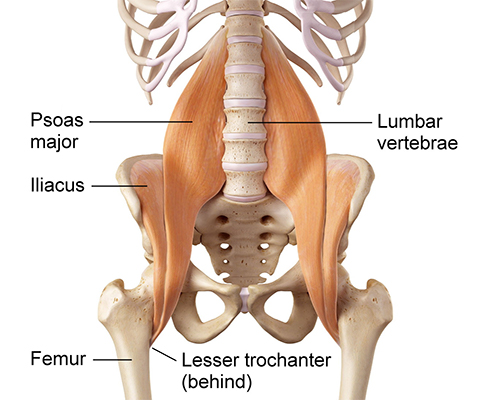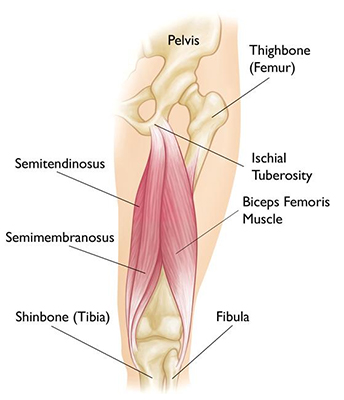
What is Ischiofemoral Impingement?
Leave a CommentIschio-what? Ischiofemoral impingement (IFI) is a rare cause of groin or posterior hip pain. This diagnosis is named after the body parts which are involved. The ischium is part of the pelvis and the femur is the big bone of your upper leg. Ischiofemoral impingement means the ischium and the femur are pinching something causing impingement. IFI is a rare diagnosis, but recently has become a common topic of research and conversations.
What Causes Ischiofemoral Impingement?
As described above, ischiofemoral impingement is pinching of a structure between two portions of bone, which make up the hip, often a portion of the quadratus femoris muscle. The psoas muscle and hamstring tendon can also be involved during an IFI injury.


The normal amount of space between a small notch on the femur and the pelvis is about 20 mm. This type of injury typically occurs when the space is less than 13 mm.2 The impingement of the quadratus femoris occurs when the hip is placed in a position of extension, adduction, and external rotation3.
Common complaints patients report when diagnosed with ischiofemoral hip impingement include1:
- Posterior hip pain
- Groin pain
- Snapping in the hip
- Discomfort with prolonged sitting
It is important to rule out other hip and low back causes of pain prior to treating this injury. In an IFI diagnosis, you will notice3:
- Tenderness near the sit bone
- Positive IFI test for pain
- Positive long-stride test for pain
An Athletico physical therapist has specialized training on the hip joint and can thoroughly assess your hip pain and perform the above listed tests.
Diagnosing and Treating IFI
An x-ray or MRI can be utilized to provide images of the hip joint and surrounding soft tissues. MRI may show an increase in edema (or swelling) and signaling of the quadratus femoris muscle, but can also show iscihofemoral space narrowing and other soft tissue involvement2. IFI is commonly treated with conservative measures first, followed by surgery when conservative care is failed. A diagnostic injection can also be utilized to ensure an IFI diagnosis3.
- Physical Therapy (PT): Physical therapy can help with differential diagnosis of IFI. When receiving physical therapy for IFI, you can expect exercises and stretches to improve control of the pelvis and lower limbs, specifically when performing movements or activities that involve hip extension, adduction, and external rotation. Utilizing graded increases in quadratus femoris muscle activation is also important for reducing inflammation and improving strength and stability. Treatment for this condition can include: balance, core and hip stabilization, as well as mobility exercises. Physical therapy can help to improve and normalize movement patterns and improve functional independence and quality of life. PT can also decrease the need for surgical intervention.
- Surgery: Surgery can be utilized when conservative care, such as physical therapy and injections, fail to provide lasting relief and improved function. Physical therapy is also utilized following surgery to restore mobility, rebuild strength, and reduce pain1.
Hip Arthroscopy Prevention
To help with differential diagnosis of the hip and to improve outcomes for functional independence, Athletico Physical Therapy is proud to offer the Hip Preservation Program. While these minimally invasive hip surgeries, cannot be prevented, Athletico’s Hip Preservation Program can help individuals improve mobility and function to continue recreational/professional activities.
Do you have hip pain? Contact Athletico for a free assessment. The Athletico team will take a look at your condition and provide recommendations for a treatment plan. Free assessments are available in-clinic and virtually via our Telehealth platform.
If you are interested in learning more about Athletico’s Hip Preservation Program, please email hip@athletico.com.
Physical therapy is usually the thing you are told to do after medication, x-rays or surgery. The best way to fix your pain is to start where you normally finish – with physical therapy at Athletico. Schedule a free assessment in-clinic or virtually through a secure online video chat where our team can assess your pain and provide recommended treatment options.
The Athletico blog is an educational resource written by Athletico employees. Athletico bloggers are licensed professionals who abide by the code of ethics outlined by their respective professional associations. The content published in blog posts represents the opinion of the individual author based on their expertise and experience. The content provided in this blog is for informational purposes only, does not constitute medical advice and should not be relied on for making personal health decisions.
Resources:
1. Mallac. (2019, March 28). Uncommon injuries: Ischio-femoral impingement. Retrieved August 09, 2020, from https://www.sportsinjurybulletin.com/uncommon-injuries-ischio-femoral-impingement/
2. Stafford, G. H., & Villar, R. N. (2011). Ischiofemoral impingement. The Journal of Bone and Joint Surgery, 93-B.
3. Wilson, M. D., & Keene, J. S. (2016). Treatment of ischiofemoral impingement: Results of diagnostic injections and arthroscopic resection of the lesser trochanter. Journal of Hip Preservation Surgery, 3.
